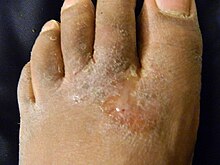Acute Vesicular Athletes Foot is characterized by a quick onset of painful blisters either on the sole of the persons foot or on the top of their foot. Moccasin athletes foot is when it occurs around the bottom of your foot.
 Bilateral Moccasin Type Tinea Pedis Lesions Moccasin Type Tinea Pedis Download Scientific Diagram
Bilateral Moccasin Type Tinea Pedis Lesions Moccasin Type Tinea Pedis Download Scientific Diagram
Fungal athletes foot may also be seen along with ringworm of the groin especially in men or hands.

Types of athlete's foot. Seeking care from a Phoenixville podiatrist for serious cases of athletes foot is the best course of action to find relief and prevent complications. Research has indicated that there are three specific types of athletes foot. This contagious fungus lives and thrives in warm and moist environments consisting of public pools shower room floors and surrounding areas.
Another type of athletes foot vesicular infection can happen anywhere in the foot area and it particularly affects people during summers. The skull moccasin athletes foot because it looks like youre wearing a moccasin of that dry skin with flaking and inching along the bottom of your skin. Interdigital infections may be dry or macerated soft from being wet.
There are three types of athletes foot. If any case of athletes foot grows unbearable consultation from a foot doc-tor New Haven should be sought without haste. Small red blisters between the soles and toes with an itchy painful rash are common symptoms of this fungal infection.
Interdigital toe webs moccasin vesicular blisters and ulcerative. It ordinarily happens between the two littlest toes. It is caused by a fungal infection produced by a class of parasites of the skin known as dermatophytes.
The fungus thrives in the moist conditions produced by sweat. Toe web infection The most commonly diagnosed type of athletes foot where the. When Athletes Foot is a.
Of the 3 types toe web is the most common while vesicular is the least common type of athletes foot. Moccasin athletes foot. Athletes foot is a skin infection that affects 70 of the population at various times.
If the fungus covers the sole of your foot its called a moccasin infection. Although athletes foot is commonly used as a catch-all term specific conditions always fall under one of three categories. Kinds of Athletes Foot.
This contagious fungus lives and thrives in warm and moist environments consisting of public pools shower room floors and surrounding areas. Your doctor may call this an interdigital infection. Fungal athletes foot may cause a rash on one or both feet and even involve the hand.
Acute Vesicular Athletes Foot is caused by Trichophyton Mentagrophytes. You may see the rash. Moccasin-type is often a chronic condition that should be evaluated by a podiatrist.
A common type of fungal infection is known as athletes foot. What Are the Types of Athletes Foot. Also called toe web disease this is the most widely recognized sort of competitors foot.
Find athletes foot stock images in HD and millions of other royalty-free stock photos illustrations and vectors in the Shutterstock collection. Bursting of the blisters can also lead to a bacterial infection that may require. Research has indicated that there are three specific types of athletes foot.
Thousands of new high-quality pictures added every day. Athletes foot can be categorized into four main types. This type of competitors foot can cause tingling consuming and scaling and the disease can spread to the bottom of the foot.
A two feet and one hand pattern is a very common presentation of an athletes foot especially in men. Athletes foot is a contagious fungal infection of the skin of the feet. There are three types of athletes foot.
It can cause symptoms such as red flaky peeling or cracking skin on the feet itching blistering and a red scaly rash. Hand fungal infections are called tinea manuum. A common type of fungal infection is known as athletes foot.
That just means its between the fingers or toes. Each type of athletes foot affects different areas of the feet and hence different symptoms are noticed. This type of athletes foot usually starts in persons who have a chronic interdigital toe web infection.